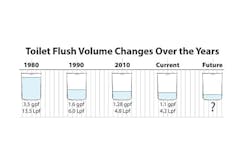PERC research helps determine the water efficiency threshold
Transporting waste down the drain happens all day, every day. As such, when it no longer works effectively we all notice and wonder: what now? As a plumbing contractor, the question really is: how low can you go (with flush volumes, that is) before unintended consequences occur?
It all goes back to the Energy Policy Act of 1992, where water use reduction in plumbing fixtures became a federal law at the national level, and unknowingly began a debate of drain line transport efficacy.
Fast forward to today, the plumbing market transitions towards 4.8 Lpf / 1.28 gpf toilets, and continues to push the envelope by reducing consumption levels (to 1.1 gpf for example) … And the debate continues.
Although reducing the water usage of plumbing fixtures prompts the emergence of low-flow, high efficiency toilets that support water conservation, unintentional consequences such as the lack of water pressure can negatively affect the drain line carry efficiency.
Slope, toilet paper critical to drainline carry
Down the Drain: New white paper from sloan examines PERC study results
The challenge is how can the existing drain lines and sewers, which were built using early 20th century design criteria for high‐volume fixtures and less concentrated wastewater flows, be adapted to operate satisfactorily under significantly reduced flows associated with emerging high-efficiency water‐efficient plumbing systems and fixtures? In other words, how low is low?
Recognizing that ongoing efforts to make plumbing systems as efficient as possible are a certainty, the PERC I (Plumbing Efficiency Research Coalition) study sought to answer the question of how low and under what conditions are too low a flow. They applied a scientific approach toward a better understanding of drain line function under lower flow conditions, so that the plumbing industry can work proactively to prevent widespread unintended blockages.
PERC I conclusions
The conclusions of the PERC I tests are interesting. Overall, the results provide a thorough understanding of what can impact drain line transport. The factors impacting transport are:
- What is the tensile strength of the toilet paper squares that are being used?
- What is the slope of the drain line you are about to flush into?
- What is the flush volume you are using to begin the whole process?
Ignoring any one of those questions puts a building at risk.
While additional research is not only suggested, but encouraged, what PERC uncovered provides a deeper understanding of drain line behaviors for contractors. For example, as far as a clearing flush is concerned – the flush intended to clear the drain line at the end of a 40 test run – it cleared the drain line in 32 of 40 test runs. Prior international studies have concluded that toilet hydraulics is a significant factor in drain line transport, specifically pointing to the amount of trailing water as a key factor.
In PERC I, a clearing flush was found to be a non-significant variable. That is, toilet discharge characteristics, or how fast the volume of water is introduced in combination with the fixture as a result of the hydraulics, had no significant effect on drain line transport. Therefore, the committee concluded that toilet fixture designs have a minimal effect on drain line transport in long building drains.
However, there may be more to it than just “how fast” the water is presented. In fact, the flush curve and toilet design is important – certainly for bowl evacuation and potentially for drain line carry.
Drain line carry aside, fixture design must contend with user and housekeeping issues: cleanliness and scrubbing action of bowl, splashing and noise, all while contending with ever-lowering flush volumes. Toilet hydraulics will always be important to the overall performance of waste evacuation and transport, but not necessarily to drain line performance! On the contrary, a real-world test is called for and should be considered before final judgment is rendered.
Beyond PERC
Using low-flow high-efficiency toilet systems can be easily designed to perform in new construction projects. In a new facility, for example, the water supply system and the drainage pipes can be designed to accommodate the higher operating pressures and efficient drain flows, by properly specifying drain size for these new water-efficient plumbing products. Using a 1.1 gpf toilet system (flushometers, fixtures, and waste drains) within the plumbing design can be an effective solution.
However, the PERC I study does not address or recognize the larger base of existing buildings and their existing plumbing infrastructure. When incorporating high-efficiency flushometers and fixtures in an existing building, such as in a retrofit or a remodel, it often requires greater consideration of the existing waste drain conditions and capacities of the drainage and supply systems.
Anything below 1.28 gpf systems are circumspect – there are variables that can negatively impact drain line carry. Above 1.28 gpf has so far proven itself in the commercial marketplace.
When dealing with an older plumbing system, therefore, additional important factors than those studied in PERC I must be taken into consideration to ensure that the use of these lower flushing – flushometers and-fixtures will not impact fixture and system performance, negating the benefit of the water savings that is trying to be achieved.
Water conservation is still possible in older buildings. However, accommodation must be made for factors such as bowl performance, drainage, water supply and other variables that directly impact the goals of water conservation.
If there is a concern about the efficacy of an existing drain line, then that’s where you as a contractor come in. It’s your job to evaluate and ensure the system is capable of performing adequately on the reduced flows.
For example, one strategy practiced by contractors is to recommend upgrading one restroom with high-efficiency fixtures and flushometers first as a test and evaluate the system performance for a period of time to see if there are any adverse effects on the drain line carry before changing the whole building.
In a building where there may be drainage concerns, using a 1.6/1.1 gpf (6.0/4.2 Lpf) dual flush instead of a 1.28 gpf (4.84 Lpf) single flush is often another viable solution. The 1.6/1.1 gpf (6.0/4.2 Lpf) dual flush is recognized in most codes as a high-efficiency flushing device, equivalent to a 1.28 gpf (4.84 Lpf) single flush.
The additional water delivered for the full flush (the solids flush) is often, but not always, enough to overcome these adverse conditions in an old drainage system. The reduced liquid flush offsets the extra water used for the solid flush, particularly as liquid flushing (often with light solids like tissue paper) typically occurs twice as often as a ‘solids’ flush.
Recommendations
Because plumbing systems are part art and part science, they continue to influence plumbing performance and human comfort. With the PERC I study in mind, using the following checklist when evaluating your plumbing options for your customers:
1. Consideration of slope, flush volume and type of toilet paper in all retrofit applications.
2. Whenever possible, physically inspect drain lines of existing buildings prior to specification or recommendations.
3. Stabilize performance of the flush volumes being recommended. Consider 1.1 gpf/4.2 Lpf where the design characteristics of the drain line are appropriate.
4. Whenever possible on retrofit jobs, test install a floor or set of particularly heavy traffic restrooms with high-efficiency fixtures in order to evaluate a complete change out of the retrofit site. Some progressive contractors actually recommend this, especially if the retrofit is going from Pre-EPAct water closets of 3.5 gpf down to 1.28 gpf or below.
5. Encourage the manufacturers of toilet paper to begin consideration of publishing tensile strength characteristics to better inform engineers and end users (since the data clearly suggests that the selection of toilet paper is definitely more significant than other toilet flush characteristics, i.e., flush rate and trailing water).
While the PERC I study provides important insights, it also raises new questions, providing an opportunity for further research. PERC Phase 2 will focus on the following research areas: pipe size reduction, additional flush volume levels, toilet discharge and toilet paper characteristics. Stay tuned!
PERC was formed Jan. 6, 2009, when five organizations signed a Memorandum of Understanding to meet the needs of the critical topic of what happens when you lower the volume of water in plumbing systems to control waste. These organizations are: Alliance for Water Efficiency, International Association of Plumbing & Mechanical Officials, International Code Council, Plumbing-Heating-Cooling Contractors—National Association, Plumbing Manufacturers International and American Society of Plumbing Engineers. Today, these six organizations now form the leading edge thinking that seeks to make plumbing systems as efficient as possible.
The PERC I study sought to apply a scientific approach towards a better understanding of drain line function under lower flow conditions so that the plumbing industry can work proactively to prevent widespread blockages from becoming a reality. By carefully controlling certain variables, the PERC I study sought to learn how drain lines react and which of these variables impact performance significantly and which variables do not.
Mike Gipson is the product line manager of flushometers at Sloan Valve Company. He has more than 30 years of product management and marketing experience. Gipson graduated from Augustana College and earned his MBA from The University of Illinois. He can be reached at [email protected].


